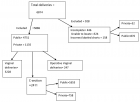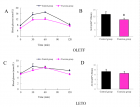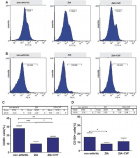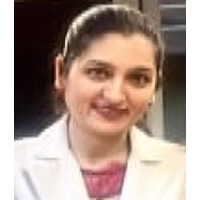Abstract
Research Article
Comparative analysis of cesarean section using the Robson's Ten-Group Classification System (RTCGS) in private and public hospitals, Addis Ababa, Ethiopia
Endalkachew Mekonnen Assefa*, Adem Janbo and Yirgu Ghiwot
Published: 29 June, 2021 | Volume 4 - Issue 2 | Pages: 081-091
Objectives: We analyzed the indications of cesarean section (CS) using Robson Ten-Group.
Classification Systems (RTGCS) and comparison between private and public health facilities in Addis Abeba hospitals, Ethiopia, 2017.
Methods: Facility-based retrospective cross-sectional study was carried out between January 1 and December 31, 2017, including 2411 mothers who delivered by CS were classified using the RTGCS. Data were entered into SPSS version 20 for cleaning and analyzing. Binary logistic regression and AOR with 95% CI were used to assess the determinants of the CS.
Results: The overall CS rate was 41% (34.8% and 66.8% in public & private respectively, p < .0001). The leading contributors for CS rate in the private were Robson groups 5,1,2,3 whereas in the public 5,1,3,2 on descending order. Robson group 1 (nulliparous, cephalic, term, spontaneous labor) and group 3 [Multiparous (excluding previous cesarean section), singleton, cephalic, ≥ 37 weeks’ gestation& spontaneous labor], the CS rate was over two-fold higher in the private than the public sector. Women in Robson groups 1, 2, 5 & 9 are two and more times higher for the absolute contribution of CS in private than public. The top medical indications of CS were non-reassuring fetal status (NRFS, 39.1%) and repeat CS for previous CS scars (39.4%) in public and private respectively. Mothers who delivered by CS in private with history of previous CS scar (AOR 2.9, 95% CI 1.4-6.2), clinical indications of maternal request (AOR 7.7, 95% CI 2.1-27.98) and pregnancy-induced hypertension (AOR 4.2, 95% CI 1.6-10.7), induced labor (AOR 2.5, 95% CI 1.4-4.6) and pre-labored (AOR 2.2, 95% CI 1.6-3.0) were more likely to undergo CS than in public hospital.
Conclusion: The prevalence of CS was found to be high, and was significantly higher in private hospitals than in a public hospital. Having CS scar [having previous CS scar, Robson group 5(Previous CS, singleton, cephalic, ≥ 37 weeks’ gestation) and an indication of repeat CS for previous CS scar] is the likely factor that increased the CS rate in private when compared within the public hospital.
Recommendation: It is important that efforts to reduce the overall CS rate should focus on reducing the primary CS, encouraging vaginal birth after CS (VBAC). Policies should be directed at the private sector where CS indication seems not to be driven by medical reasons solely.
Read Full Article HTML DOI: 10.29328/journal.cjog.1001093 Cite this Article Read Full Article PDF
Keywords:
Addis Ababa; Cesarean section; Robson classification; Indications; Private; Public
References
- Cesarean Delivery: Overview, Preparation, Technique. 2019. https://emedicine.medscape.com/article/263424-overview
- Lyell DJ, Power M, Murtough K, Ness A, Anderson B, et al. Surgical Techniques at Cesarean Delivery: A U.S. Survey. Surg J (NY). 2016; 2: e119–25. PubMed: https://www.ncbi.nlm.nih.gov/pmc/articles/PMC5553495/
- Management protocol on selected obstetrics topics. Federal Democratic Republic of Ethiopia Ministry of Health. https://www.academia.edu/40819328/MANAGEMENT_PROTOCOL_ON_SELECTED_OBSTETRICS_TOPICS_Federal_Democratic_Republic_of_Ethiopia_Ministry_of_Health
- Betrán AP, Ye J, Moller AB, Zhang J, Gülmezoglu AM, et al. The Increasing Trend in Caesarean Section Rates: Global, Regional and National Estimates: 1990-2014. PloS One. 2016; 11: e0148343. https://journals.plos.org/plosone/article?id=10.1371/journal.pone.0148343
- Boatin AA, Schlotheuber A, Betran AP, Moller AB, Barros AJD, et al. Within country inequalities in caesarean section rates: observational study of 72 low and middle income countries. BMJ. 2018; k55. http://www.bmj.com/lookup
- Hanson C, Betrán AP, Opondo C, Mkumbo E, Manzi F, et al. Trends in caesarean section rates between 2007 and 2013 in obstetric risk groups inspired by the Robson classification: results from population-based surveys in a low-resource setting. BJOG. 2019; 126: 690–700. PubMed: https://pubmed.ncbi.nlm.nih.gov/30461161/
- Boerma T, Ronsmans C, Melesse DY, Barros AJD, Barros FC, et al. Global epidemiology of use of and disparities in caesarean sections. The Lancet. 2018; 392: 1341–1348. PubMed: https://pubmed.ncbi.nlm.nih.gov/30322584/
- Harrison MS, Goldenberg RL. Cesarean section in sub-Saharan Africa. Maternal Health, Neonatology and Perinatology. 2016; 2: 6. PubMed: https://pubmed.ncbi.nlm.nih.gov/27398224/
- Chu K, Cortier H, Maldonado F, Mashant T, Ford N, et al. Cesarean section rates and indications in sub-Saharan Africa: a multi-country study from Medecins sans Frontieres. PLoS One. 2012; 7: e44484. PubMed: https://pubmed.ncbi.nlm.nih.gov/22962616/
- Dikete M, Coppieters Y, Trigaux P, Fils JF, Englert Y, et al. Variation of caesarean section rates in Sub-Saharan Africa: A literature review. J Gynecol Res Obstet. 2019; 5: 042-047. https://www.peertechz.com/articles/JGRO-5-171.php
- Ethiopia - Demographic and Health Survey 2016. https://microdata.worldbank.org/index.php/catalog/2886
- Yisma E, Smithers LG, Lynch JW, Mol BW. Cesarean section in Ethiopia: prevalence and sociodemographic characteristics. J Matern Fetal Neonatal Med. 2019; 2: 1130-1135. PubMed: https://pubmed.ncbi.nlm.nih.gov/29103331/
- Fesseha N, Getachew A, Hiluf M, Gebrehiwot Y, Bailey P. A national review of cesarean delivery in Ethiopia. Int J Gynecol Obstetr. 2011; 115: 106–111. https://obgyn.onlinelibrary.wiley.com
- WHO Statement on caesarean section rates. Reproductive Health Matters. 2015; https://www.tandfonline.com/doi/abs
- Almeida MA, Araujo Júnior E, Camano L, Peixoto AB, Martins WP, et al. Impact of cesarean section in a private health service in Brazil: indications and neonatal morbidity and mortality rates. Ceska Gynekol. 2018; 83: 4–10.
- Phadungkiatwattana P, Tongsakul N. Analyzing the impact of private service on the cesarean section rate in public hospital Thailand. Arch Gynecol Obstet. 2011; 284: 1375-1379. PubMed: https://pubmed.ncbi.nlm.nih.gov/21359844/
- Tura AK, Pijpers O, de Man M, Cleveringa M, Koopmans I, et al. Analysis of caesarean sections using Robson 10-group classification system in a university hospital in eastern Ethiopia: a cross-sectional study. BMJ Open. 2018; 8: e020520. PubMed: https://pubmed.ncbi.nlm.nih.gov/29622577/
- Nakamura-Pereira M, do Carmo Leal M, Esteves-Pereira AP, Domingues RMSM, Torres JA, et al. Use of Robson classification to assess cesarean section rate in Brazil: the role of source of payment for childbirth. Reprod Health. 2016; 13(Suppl 3): 128. PubMed: https://pubmed.ncbi.nlm.nih.gov/27766941/
- World Health Organization. Robson Classification: Example of Robson Report Table with Interpretation. WHO/RHR/1722. 2017; www.who.int/reproductivehealth/publications/maternal_perinatal_health/robson-classification/en/
- Vogel JP, Betrán AP, Vindevoghel N, Souza JP, Torloni MR, et al. Use of the Robson classifi cation to assess caesarean section trends in 21 countries: a secondary analysis of two WHO multicountry surveys. Lancet Glob Health. 2015; 3: e260-270. PubMed: https://pubmed.ncbi.nlm.nih.gov/25866355/
- Maskey S, Bajracharya M, Bhandari S. Prevalence of Cesarean Section and Its Indications in A Tertiary Care Hospital. JNMA J Nepal Med Assoc. 2019; 57: 70–73. PubMed: https://pubmed.ncbi.nlm.nih.gov/31477935/
- Chaudhary R, Raut KB, Pradhan K. Prevalence and Indications of Cesarean Section in a Community Hospital of Western Region of Nepal. JNMA J Nepal Med Assoc. 2018; 56: 871–874. PubMed: https://pubmed.ncbi.nlm.nih.gov/31065123/
- Gedefaw G, Demis A, Alemnew B, Wondmieneh A, Getie A, et al. Prevalence, indications, and outcomes of caesarean section deliveries in Ethiopia: a systematic review and meta-analysis. Patient Safety in Surgery. 2020; 14: 11. PubMed: https://pubmed.ncbi.nlm.nih.gov/32292491/
- Wondie AG, Zeleke AA, Yenus H, Tessema GA. Cesarean delivery among women who gave birth in Dessie town hospitals, Northeast Ethiopia. PLoS ONE. 2019; 14: e0216344. PubMed: https://pubmed.ncbi.nlm.nih.gov/31059526/
- Aman H, Negash S, Yusuf L. Cesarean delivery practices in teaching public and non-government/private MCH hospitals, Addis Ababa. Ethiopian J Health Develop. 2014; 28: 22–28. https://www.ajol.info/index.php/ejhd/article/view/115406
- Gebremedhin S. Trend and socio-demographic differentials of Caesarean section rate in Addis Ababa, Ethiopia: analysis based on Ethiopia demographic and health surveys data. Reprod Health. 2014; 11: 14. PubMed: https://pubmed.ncbi.nlm.nih.gov/24563907/
- Tsega F, Mengistie B, Dessie Y, Mengesha MM. Prevalence of Cesarean Section in Urban Health Facilities and Associated Factors in Eastern Ethiopia: Hospital Based Cross Sectional Study. J Pregnancy Child Health. 2015; 2: 1–5. https://www.omicsonline.org/open-access/prevalence-of-cesarean-section-in-urban-health-facilities-and-associated-factors-in-eastern-ethiopia-hospital-based-cross-sectional-study-2376-127X-1000169.php?aid=54258
- Melesse MB, Geremew AB, Abebe SM. High prevalence of caesarean birth among mothers delivered at health facilities in Bahir Dar city, Amhara region, Ethiopia. A comparative study. PLoS ONE. 2020; 15: e0231631. PubMed: https://www.ncbi.nlm.nih.gov/pmc/articles/PMC7162673/
- Alonso BD, da Silva FMB, do Rosário M, et al. Caesarean birth rates in public and privately funded hospitals: a cross-sectional study. Rev Saude Publica. 2017; 51: 101. PubMed: https://pubmed.ncbi.nlm.nih.gov/29166449/
- M N, G A, K A, A K, D O, Ns M, et al. Prevalence and determinants of caesarean section in private and public health facilities in underserved South Asian communities: cross-sectional analysis of data from Bangladesh, India and Nepal. BMJ open. 2014; 4. PubMed: https://pubmed.ncbi.nlm.nih.gov/25550293/
- Eyi EGY, Mollamahmutoglu L. An Analysis of the High Cesarean Section Rates in Turkey by Robson Classification. J Matern Fetal Neonatal Med. 2021; 34: 2682-2692. PubMed: https://pubmed.ncbi.nlm.nih.gov/31570019/
- Einarsdóttir K, Haggar F, Pereira G, Leonard H, Klerk N de, Stanley FJ, et al. Role of public and private funding in the rising caesarean section rate: a cohort study. BMJ Open. 2013; 3: e002789. https://bmjopen.bmj.com/content/3/5/e002789
- Elena SV, Marta U, Fern AV, Yazmin LBI, Hazel HRC. The Epidemic of the Cesarean Section in Private Hospital in Puebla, México. 2015.
- Vieira GO, Fernandes LG, de Oliveira NF, Silva LR, Vieira T de O. Factors associated with cesarean delivery in public and private hospitals in a city of northeastern Brazil: a cross-sectional study. BMC Pregnancy Childbirth. 2015; 15: 132. PubMed: https://pubmed.ncbi.nlm.nih.gov/26043857/
- Kazmi T, Sarva Saiseema V, Khan S. Analysis of Cesarean Section Rate - According to Robson’s 10-group Classification. Oman Med J. 2012; 27: 415–417. PubMed: https://www.ncbi.nlm.nih.gov/pmc/articles/PMC3472574/
- Tognon F. Analysis of caesarean section and neonatal outcome using the Robson classification in a rural district hospital in Tanzania: an observational retrospective study. MJ Open. 2019; 9: e033348.
- Zimmo MW, Laine K, Hassan S, Bottcher B, Fosse E, et al. Caesarean section in Palestine using the Robson Ten Group Classification System: a population-based birth cohort study. BMJ Open. 2018; 8: e022875. PubMed: https://pubmed.ncbi.nlm.nih.gov/30361403/
- Naidoo N, Moodley J. Rising rates of Caesarean sections: an audit of Caesarean sections in a specialist private practice. South African Family Practice. 2009; 51. https://www.ajol.info/index.php/safp/article/view/44790
- Betrán AP, Temmerman M, Kingdon C, Mohiddin A, Opiyo N, et al. Interventions to reduce unnecessary caesarean sections in healthy women and babies. The Lancet. 2018; 392: 1358–1368. https://linkinghub.elsevier.com/retrieve/pii/S0140673618319275
- Safe Prevention of the Primary Cesarean Delivery. 2020. https://www.acog.org/en/Clinical/Clinical Guidance/Obstetric Care Consensus/Articles/2014/03/
- Rossi AC, D’Addario V. Maternal morbidity following a trial of labor after cesarean section vs elective repeat cesarean delivery: a systematic review with metaanalysis. Am J Obstet Gynecol. 2008; 199: 224–231. PubMed: https://pubmed.ncbi.nlm.nih.gov/18511018/
- Buchmann EJ. Trial of labour after previous caesarean section in sub-Saharan Africa. BJOG. 2016; 123: 2156.
- Kietpeerakool C, Lumbiganon P, Laopaiboon M, Rattanakanokchai S, Vogel JP, et al. Pregnancy outcomes of women with previous caesarean sections: Secondary analysis of World Health Organization Multicountry Survey on Maternal and Newborn Health. Sci Rep. 2019; 9. PubMed: https://www.ncbi.nlm.nih.gov/pmc/articles/PMC6611838/
- Rudey EL, do Carmo Leal M, Rego G. Cesarean section rates in Brazil Trend analysis using the Robson classification system. 2020; 99: 17: e19880. PubMed: https://pubmed.ncbi.nlm.nih.gov/32332659/
- Tapia V, Betran AP, Gonzales GF. Caesarean Section in Peru: Analysis of Trends Using the Robson Classification System. PLoS One. 2016; 11: e0148138. PubMed: https://pubmed.ncbi.nlm.nih.gov/26840693/
- Barčaitė E, Kemeklienė G, Railaitė DR, Bartusevičius A, Maleckienė L, et al. Cesarean Section Rates in Lithuania Using Robson Ten Group Classification System. Medicina (Kaunas). 2015; 51: 280–285.
- Tsegaye H, Desalegne B, Wassihun B, Bante A, Fikadu K, et al. Prevalence and associated factors of caesarean section in Addis Ababa hospitals, Ethiopia. Pan African Med J. 2019; 34. https://www.panafrican-med-journal.com/content/article/34/136/full/
- Hanvoravongchai P, Letiendumrong J, Teerawattananon Y, Tangcharoensathien V. Implications of Private Practice in Public Hospitals on the Cesarean Section Rate in Thailand. 2020; 11.
- Alonso BD, Silva FMB da, Latorre M do RD de O, Diniz CSG, Bick D. Caesarean birth rates in public and privately funded hospitals: a cross-sectional study. Rev Saude Publica. 2017; 51: 101. PubMed: https://pubmed.ncbi.nlm.nih.gov/29166449/
Figures:

Figure 1

Figure 2
Similar Articles
-
Perinatal Morbidity & Mortality following repeat Cesarean section due to five or more previous Cesarean Section done in Tertiary centre in KSASomia Osman,Gehan Farid*,Reem Mohamed Kamal,Sarah Rabie Ali,Mohamed AH Swaraldahab. Perinatal Morbidity & Mortality following repeat Cesarean section due to five or more previous Cesarean Section done in Tertiary centre in KSA. . 2018 doi: 10.29328/journal.cjog.1001007; 1: 045-051
-
Current anesthesıa for Cesarean SectıonDemet Dogan Erol*, Ismail Aytac. Current anesthesıa for Cesarean Sectıon. . 2018 doi: 10.29328/journal.cjog.1001011; 1: 061-066
-
Immediate postplacental insertion of intrauterine contraceptive device (copper 375) and its complications in term of expulsion, infection and perforationBenish Khanzada*,Mala Jitendra Shahani,Areesha Kamran Khanzada. Immediate postplacental insertion of intrauterine contraceptive device (copper 375) and its complications in term of expulsion, infection and perforation . . 2018 doi: 10.29328/journal.cjog.1001014; 1: 082-086
-
Determinants of women’s perceived satisfaction on Antenatal care in urban Ghana: A cross-sectional studyAkowuah Jones Asafo*,Danquah Benedicta Adoma. Determinants of women’s perceived satisfaction on Antenatal care in urban Ghana: A cross-sectional study. . 2019 doi: 10.29328/journal.cjog.1001022; 2: 038-053
-
Trial of labor after cesarean outcomes with excessive gestational weight gainSophia Halassy*,Angela Marras. Trial of labor after cesarean outcomes with excessive gestational weight gain. . 2020 doi: 10.29328/journal.cjog.1001048; 3: 039-042
-
Triple negative breast cancer: Early stages management and evolution, a two years experience at the department of breast cancer of CHSFBouzid Nassima,Darido Jessie*,Diari Jed,Dussour Chloe,Ezenfis Joel,Cahn Virginie,Guekeu Steven,Rigonnot Luc. Triple negative breast cancer: Early stages management and evolution, a two years experience at the department of breast cancer of CHSF. . 2020 doi: 10.29328/journal.cjog.1001052; 3: 065-078
-
Comparative analysis of cesarean section using the Robson's Ten-Group Classification System (RTCGS) in private and public hospitals, Addis Ababa, EthiopiaEndalkachew Mekonnen Assefa*,Adem Janbo,Yirgu Ghiwot. Comparative analysis of cesarean section using the Robson's Ten-Group Classification System (RTCGS) in private and public hospitals, Addis Ababa, Ethiopia. . 2021 doi: 10.29328/journal.cjog.1001093; 4: 081-091
-
Severe preeclampsia at the University Hospital Center of Mother and Child (UHCMC) in N’djamena: Epidemiology and prognosisFoumsou L*,Kouamé A,Danmadji NL,Gabkika BM,Damthéou S,Aché H. Severe preeclampsia at the University Hospital Center of Mother and Child (UHCMC) in N’djamena: Epidemiology and prognosis. . 2022 doi: 10.29328/journal.cjog.1001099; 5: 009-012
-
To compare serum Vitamin D status in pre-eclamptic and non-preeclamptic pregnant women in labour: A tertiary care centre study of Northern IndiaMonica Karpa,Sita Thakur,Kamal Singh*,Jyoti Sharma,Harsha Chaudhary. To compare serum Vitamin D status in pre-eclamptic and non-preeclamptic pregnant women in labour: A tertiary care centre study of Northern India. . 2022 doi: 10.29328/journal.cjog.1001100; 5: 013-018
-
Timely initiation of breastfeeding and associated factors among mothers with vaginal and cesarean deliveries in public hospitals of Addis Ababa, EthiopiaAdane Mekonnen*,Zewdu Shewangizaw. Timely initiation of breastfeeding and associated factors among mothers with vaginal and cesarean deliveries in public hospitals of Addis Ababa, Ethiopia. . 2022 doi: 10.29328/journal.cjog.1001106; 5: 044-050
Recently Viewed
-
The efficacy of complex Decongestive Physiotherapy in patients with Bilateral Primary Lower Extremity Lymphedema and Untreatable multiple health conditions: A Case ReportHümeyra Kiloatar PT*. The efficacy of complex Decongestive Physiotherapy in patients with Bilateral Primary Lower Extremity Lymphedema and Untreatable multiple health conditions: A Case Report. J Nov Physiother Rehabil. 2017: doi: 10.29328/journal.jnpr.1001011; 1: 093-098
-
Cystoid Macular Oedema Secondary to Bimatoprost in a Patient with Primary Open Angle GlaucomaKonstantinos Kyratzoglou*,Katie Morton. Cystoid Macular Oedema Secondary to Bimatoprost in a Patient with Primary Open Angle Glaucoma. Int J Clin Exp Ophthalmol. 2025: doi: 10.29328/journal.ijceo.1001059; 9: 001-003
-
Metastatic Brain Melanoma: A Rare Case with Review of LiteratureNeha Singh,Gaurav Raj,Akshay Kumar,Deepak Kumar Singh,Shivansh Dixit,Kaustubh Gupta*. Metastatic Brain Melanoma: A Rare Case with Review of Literature. J Radiol Oncol. 2025: doi: ; 9: 050-053
-
Depression as a civilization-deformed adaptation and defence mechanismBohdan Wasilewski*,Olha Yourtsenyuk,Eugene Egan. Depression as a civilization-deformed adaptation and defence mechanism. Insights Depress Anxiety. 2020: doi: 10.29328/journal.ida.1001013; 4: 008-011
-
Drinking-water Quality Assessment in Selective Schools from the Mount LebanonWalaa Diab, Mona Farhat, Marwa Rammal, Chaden Moussa Haidar*, Ali Yaacoub, Alaa Hamzeh. Drinking-water Quality Assessment in Selective Schools from the Mount Lebanon. Ann Civil Environ Eng. 2024: doi: 10.29328/journal.acee.1001061; 8: 018-024
Most Viewed
-
Evaluation of Biostimulants Based on Recovered Protein Hydrolysates from Animal By-products as Plant Growth EnhancersH Pérez-Aguilar*, M Lacruz-Asaro, F Arán-Ais. Evaluation of Biostimulants Based on Recovered Protein Hydrolysates from Animal By-products as Plant Growth Enhancers. J Plant Sci Phytopathol. 2023 doi: 10.29328/journal.jpsp.1001104; 7: 042-047
-
Sinonasal Myxoma Extending into the Orbit in a 4-Year Old: A Case PresentationJulian A Purrinos*, Ramzi Younis. Sinonasal Myxoma Extending into the Orbit in a 4-Year Old: A Case Presentation. Arch Case Rep. 2024 doi: 10.29328/journal.acr.1001099; 8: 075-077
-
Feasibility study of magnetic sensing for detecting single-neuron action potentialsDenis Tonini,Kai Wu,Renata Saha,Jian-Ping Wang*. Feasibility study of magnetic sensing for detecting single-neuron action potentials. Ann Biomed Sci Eng. 2022 doi: 10.29328/journal.abse.1001018; 6: 019-029
-
Pediatric Dysgerminoma: Unveiling a Rare Ovarian TumorFaten Limaiem*, Khalil Saffar, Ahmed Halouani. Pediatric Dysgerminoma: Unveiling a Rare Ovarian Tumor. Arch Case Rep. 2024 doi: 10.29328/journal.acr.1001087; 8: 010-013
-
Physical activity can change the physiological and psychological circumstances during COVID-19 pandemic: A narrative reviewKhashayar Maroufi*. Physical activity can change the physiological and psychological circumstances during COVID-19 pandemic: A narrative review. J Sports Med Ther. 2021 doi: 10.29328/journal.jsmt.1001051; 6: 001-007

HSPI: We're glad you're here. Please click "create a new Query" if you are a new visitor to our website and need further information from us.
If you are already a member of our network and need to keep track of any developments regarding a question you have already submitted, click "take me to my Query."

















































































































































